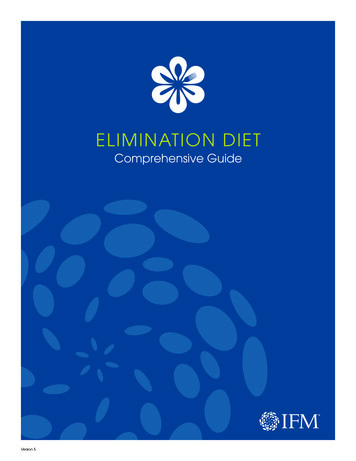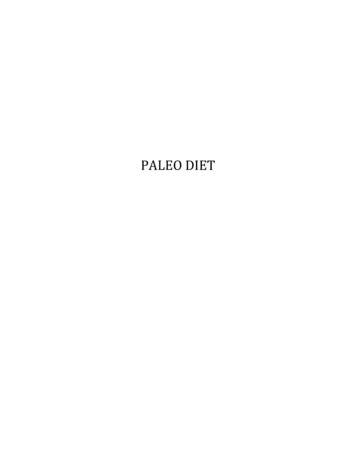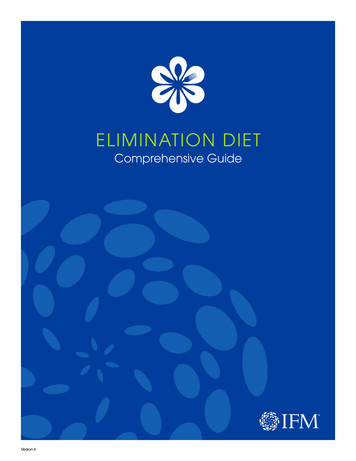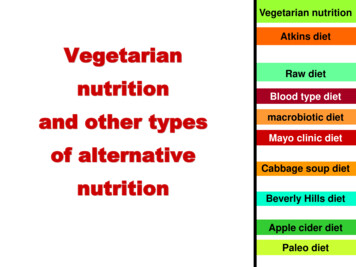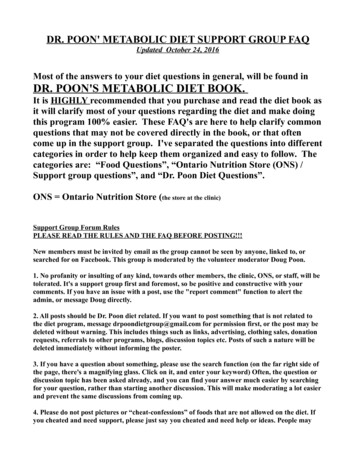
Transcription
The Elimination DietAn elimination diet is an eating plan that omits a food or group of foods believed to cause an adversefood reaction, often referred to as a “food intolerance.” By removing certain foods for a period of timeand then reintroducing them during a “challenge” period, you can learn which foods are causingsymptoms or making them worse. We often think of reactions to food as being a rapid allergic reaction,such as when a person has an anaphylactic reaction to eating peanuts and their throat swells up.However, there are other ways our bodies can react to foods that may not be so immediate, and may ormay not be tied to an immune system response. Food intolerances may be triggered by various naturalcompounds found in foods (natural sugars or proteins) or common food additives (such as natural andartificial colors, preservatives, antioxidants, and flavor enhancers) that can cause reactions throughvarious mechanisms in the body. There is currently dispute about the specific mechanisms involved indifferent reactions to foods, and many tests to identify the suspected culprit(s) can be unreliable. Clinicalexperience has shown that an elimination diet is one of the best tools for identifying food culprits and isvery safe, as long a variety of foods are still eaten supplying all the essential nutrients.SymptomsSymptoms of food intolerance can vary widely. They can include stomach and bowel irritation,headaches, hives, itching, and even vague feelings of being unwell, such as flu-like aches and pains,unusual tiredness, or concentration problems. Certain foods and food groups are also known toexacerbate symptoms in people with specific conditions such as autoimmune disorders, migraines,Irritable Bowel Syndrome, gastroesophageal reflux (GERD) and others.2Symptoms and their severity are unique to the individual. They are influenced by specific compounds inthe food, a person’s sensitivity level, and how much of certain foods are eaten. If the same food is eatenrepeatedly, or different foods with the same compound are eaten together or often, the body may reacha threshold, or a tipping point where symptoms begin to occur.Natural Food SubstancesEven “healthy” foods contain many different naturally occurring chemicals that can be a problem forsome people. Substances common to many different foods, such as salicylates, amines, and glutamate,may cause symptoms for different individuals. It is beyond the scope of this handout to provide detailabout the different categories of natural substances that may cause symptoms, but this can be exploredwith a practitioner who is comfortable working with elimination diets (not all practitioners are).Individual VariationBecause people are unique genetically, and because we each have different eating patterns, eliminationdiets have to be based on each unique individual. Eliminating the most offending food or multiple foodsand substances all at one time is the most reliable way to find out which foods may be contributing tosymptoms. A healthcare practitioner may recommend a specific plan to follow based on symptoms,typical dietary choices, and food cravings.Elimination DietPATIENT HANDOUTUniversity of Wisconsin Integrative Healthwww.fammed.wisc.edu/integrative1
The Elimination Diet StepsThere are four main steps to an elimination diet:Step 1 – PlanningWork with your health care practitioner to learn which foods might be causing problems. You may beasked to keep a diet journal for a week, listing the foods you eat and keeping track of the symptoms youhave throughout the day. See the last page of this handout for a Food Diary Chart you can use. It ishelpful to ask yourself a few key questions: What foods do I eat most often?What foods do I crave?What foods do I eat to “feel better”?What foods would I have trouble giving up?Often, these seem to be the foods that are most important to try not to eat. Also, see Table 1 for a list ofthe most common problem foods.Make a list of potential problem foods.The elimination diet can vary in intensity depending on how many suspected food culprits are beingavoided. Three different “levels” of food elimination can be followed depending on suspected food culpritsand likelihood of adhering to the diet. The three levels are described below in the Elimination DietStrategies section on page 6. It is helpful to think about choosing the strategy that is the least restrictivefirst in order to maximize successful adherence to the restrictions. However, the more restrictivestrategies are more effective at identifying cases where there are multiple food culprits.Are You Ready?Before starting an elimination diet, it is important to consider whether this is a good time to undertakethese potentially large changes in diet. Do you have any upcoming stressful life events or travel? Do youhave the resources, willingness, and energy to create new grocery lists and menus to cook new recipes?Do you have support from family and friends for eating at home, at work, or out at restaurants and otherevents? It will be important to completely eliminate the foods on your list for 2-4 weeks, so if youaccidentally eat one of the foods, you will need to start again. It will be quicker and easier if you aresuccessful the first time.Step 2 – AvoidingMake a list of foods to avoid based on your planning, and be sure of how to avoid possible “hidden foods”(See Table 3 Hidden Foods).Begin the elimination diet and for two to four weeks, follow the elimination diet without any exceptions.Don’t eat the eliminated foods whole or as ingredients in other foods. For example, if you are avoiding alldairy products, you need to check labels for whey, casein, and lactose so you can avoid them as well. ThisElimination DietPATIENT HANDOUTUniversity of Wisconsin Integrative Healthwww.fammed.wisc.edu/integrative2
step takes a lot of discipline. You must pay close attention to food labels. Be particularly careful if you areeating out, since you have less control over what goes into the food you eat. If you make a mistake andeat something on the list, you should start over.Many people notice that in the first week, especially in the first few days, their symptoms will becomeworse before they start to improve. If your symptoms become severe or increase for more than a day ortwo, consult your health care practitioner.Table 1 Common Culprits for Food Allergy and IntoleranceCommon Food and Food Component CulpritsFoodsCitrusAdditives and Natural CompoundsAntioxidants (butylated hydroxyanisole and hydroxytoluene)Dairy ProductsAspartame (NutraSweet, an artificial sweetener)EggsFlavor enhancers (monosodium glutamate)Gluten (barley, oats, rye,and wheat)Artificial Food Colors (tartrazine and other Food Dye and Coloring Act [FD&C]dyes, which are derived from coal tar)SoyLactose and other disaccharidesPeanutsNitrate and nitrites (found in preserved meats)ShellfishPreservatives (sulfites, benzoates, and sorbates)Tree NutsThickeners/stabilizers (tragacanth, agar-agar)Beef productsBiogenic amines (histamine, tyramine, octopamine, and phenylethylamine)Salicylates – naturally occurring compounds found in many fruits, vegetables,some cheeses, herbs, spices, nuts, and medications such as aspirinCornRefined sugars (depends on source of sugar)Step 3 – Challenging If your symptoms have not improved in twoweeks, continue for up to four weeks. If yoursymptoms have not improved by the end offour weeks, stop the diet and explore whetheror not to try this process again with a differentcombination of foods. You should be symptom-free for at least 5days before beginning your food challenges. If your symptoms have improved, start “challenging”your body with the eliminated foods, one food at a time. As you do this, use the Food Diary at theend of this document to keep a written record of your symptoms. To challenge your body, add a new food back in every three days. It takes three days to be sure thatyour symptoms have time to come back if they are going to. It is suggested that you eat a smallamount on day 1 of re-introduction, have about twice the amount on day two, and then an evenlarger portion on day 3. See Table 2 for a sample calendar. It is important to note that some foodsNOTE: If a food causes you to have animmediate allergic reaction, such as throatswelling, a severe rash, or other severeallergy symptoms, seek medical care andavoid food challenges unless you are directlysupervised by a physician.Elimination DietPATIENT HANDOUTUniversity of Wisconsin Integrative Healthwww.fammed.wisc.edu/integrative3
may be tolerated in small amounts, but not larger amounts. Keeping a careful food diary can be veryhelpful in identifying these foods. It is important to test with the purest form of food available. For example, to test wheat, use a purewheat cereal that contains only wheat. You may use a non-dairy milk substitute like rice or other milkas long as that milk is not on your “avoid” list. Test milk and cheese on separate occasions. Differentcheeses may be differently reactive or not, so best to test on separate occasions. Usually yogurt,cottage cheese, and butter do not need to be tested separately. For eggs, test the whites and yolksseparately using hard-boiled eggs. Food challenges should be done as systematically as possible. Some components of foods, such asthe proteins casein and whey, and the sugar lactose in dairy can be systematically isolated bycareful challenge planning. If you suspect a specific component of a food may be a culprit, try towork with a knowledgeable healthcare practitioner who can help you develop your plan. However, ifyou eliminate an entire food group, it may only be necessary to challenge with one or a few differentfoods from that group, not every unique food. As soon as a symptom returns, remove the food from the diet, make a note in the food diary andplace that food on the “allergic” list. If you are unsure if you reacted to a food, remove it from yourdiet and re-test it in 4-5 days. If a food doesn’t cause symptoms during a challenge, it is unlikely tobe a problem food and can eventually be added back into your diet. However, don’t add the foodback during this challenge period until you have completed the diet and the food challenges. In otherwords, go back off that food until you are done with challenges for all the foods you have eliminated.Step 4 – Creating A New, Long-Term DietBased on your results, your health care practitioner can help you plan a way of eating to prevent yoursymptoms. Some things to keep in mind: This is not a perfect test. It can be confusing to tell for certain if a specific food is the cause. A lot ofother factors (such as a stressful day at work) could interfere with the results. Try to keep things asconstant as possible while you are on the diet.Some people have problems with more than one food.Be sure that you are getting adequate nutrition during the elimination diet and as you change yourdiet for the long-term. For example, if you give up dairy, you must supplement your calcium fromother sources like green leafy vegetables.You may need to try several different elimination diets before you identify the problem foods.Most people tolerate this diet well, but if you cycle with the diet several times in an effort to narrow inon the food culprits, your list of allowable foods may become increasingly small. If this happens andyou find that you are becoming increasingly intolerant of, or losing enjoyment of eating, pleaseconsult a healthcare professional.You may be able to have some foods you are reactive to on an infrequent or rotational basis. Workwith a knowledgeable healthcare practitioner, if possible, to understand how to plan for this.Elimination DietPATIENT HANDOUTUniversity of Wisconsin Integrative Healthwww.fammed.wisc.edu/integrative4
Table 2 Example of an Elimination Diet Calendar*Challenge#1EliminationPeriod2 Week4 WeekElimination EliminationStep11Begin Elimination Diet2-72-7You may notice symptoms worse for a day or two8-148-30Symptoms should go away if the right foods have been removed1531Re-introduce one small portion of food #1 (for example, dairy)1632If no symptoms occur, eat about twice the amount as day 11733If no symptoms occur, eat about twice the amount as day 2Challenge#2Remove food #1 from diet again. If it did not cause symptoms, onlyadd it back to meal plan once elimination diet is over.Continue1834Re-introduce one small portion of food #2 (for example, wheat)1935If no symptoms occur, eat about twice the amount as day 12036If no symptoms occur, eat about twice the amount as day 237Remove food #2 from diet again. If it did not cause symptoms, onlyadd it back to meal plan once elimination diet is over.Re-introduce food #3 and continue 21*IMPORTANT: You only eat a new food for one to three days. Do not add it back into your meal plan again untilthe elimination diet is over. If a food causes a symptom, remove it immediately. Wait until your symptomcompletely disappears before challenging with the next food.Elimination Diet StrategiesLevel 1: Simple (Modified) Elimination Diet (or dairy and gluten-free)This is the lowest intensity diet. There are two ways to do this. The specific food, group, or additivedepends on symptoms and suspected culprits.1. Either just one food, one group of foods, or one food additive is eliminated See Table 1 for the mostcommon food culprits. This is the easiest diet to follow, but if there are more than one food or groups offoods that cause symptoms, then this diet may not prove useful. For suspected lactose intolerance,avoidance of just the dairy food group will be successful. Alternatively, lactase is the enzyme thatdigests the disaccharide lactose and can be obtained as an over-the-counter product. If eliminatinglactose make symptoms disappear, dairy may still be enjoyed on occasion with the help of lactase.2. Alternatively, the 2 most common food group culprits (dairy and wheat) are eliminated. The mostcommon groups of food proteins that can cause intolerance are cow’s milk protein and glutens fromwheat.Elimination DietPATIENT HANDOUTUniversity of Wisconsin Integrative Healthwww.fammed.wisc.edu/integrative5
Eliminate all dairy products, including milk, cream, cheese, cottage cheese, yogurt, butter, icecream, and frozen yogurt.Eliminate gluten, avoiding any foods that contain wheat, spelt, kamut, oats (certified gluten-freeallowed), rye, barley, or malt. This is the most important part of the diet. Substitute with brownrice, millet, buckwheat, quinoa, gluten-free flour products, or potatoes, tapioca and arrowrootproducts.Table 3 Simple (or Modified) Elimination DietLevel 1 – Simple (Modified) Elimination Diet– eliminates dairy, and wheatFood CategoryAllowed FoodsEliminated FoodsAnimal proteinsBeef, chicken, lamb, pork, turkeyDairy productsArrowroot, barley, buckwheat, corn, millet, oatsGrains and(gluten-free), rice, rye, sweet potato, tapioca, whiteWheatStarchespotatoes, yamsOilAny non-dairy oilsDairy-based butter and margarinesAll fruits, vegetables, salt, spices, sweeteners, and vegetable proteins are allowedLevel 2: Moderate Intensity Elimination DietIn a moderate intensity elimination diet, several foods or food groups are eliminated all at once. Ideally,the list of eliminated foods is individually tailored based on symptoms and suspected food culprits. Forexample, the low FODMaP diet may be a good choice for symptoms related to Irritable Bowel Syndrome(IBS) (see the FODMaP Diet handout).A knowledgeable healthcare practitioner can help you identify specific food culprits for your condition orsymptoms. Either follow the guidelines detailed below and in Table 4, or create a customized list. Thisversion of the elimination diet may be more successful in eliminating symptoms because it will removemore suspected culprits all at once.The suggested moderate intensity elimination diet, in addition to dairy, and wheat, eliminates eggs, alllegumes, nuts, some specific fruits and vegetables, artificial sweeteners, all animal fats, manyvegetables fats, chocolate, coffee, tea, soft drinks, and alcohol. This diet may require a longer challengeperiod to identify the food culprits. Pay attention to the fact that it may be expensive to buy the foodsrecommended. Eliminate all animal protein, but if that is not possible or desirable, fish, poultry, and lamb areconsidered to be low allergy. Choose organic/free-range sources where available.Avoid alcohol and caffeine and all products that may contain these ingredients (including sodas, coldpreparations, herbal tinctures).Avoid foods containing yeast or foods that promote yeast overgrowth, including processed foods,refined sugars, cheeses, commercially prepared condiments, peanuts, vinegar and alcoholicbeverages.Avoid simple sugars such as candy, sweets and processed foods.Drink at least 2 quarts of water per day.Elimination DietPATIENT HANDOUTUniversity of Wisconsin Integrative Healthwww.fammed.wisc.edu/integrative6
Table 4 Moderate Intensity Elimination DietLevel 2 – Moderate Intensity Elimination Diet– Eliminates several foods at onceFood CategoryAllowed FoodsEliminated FoodsAnimal proteinsEliminate animal proteins entirely or includelamb, fish, or poultry (these animal proteins areconsidered low-allergenic, but some people canhave sensitivities, so use with caution)All others, including eggs, milk, cheese,and all dairyNoneBeans, bean sprouts, lentils, peanuts,peas, soy, all other nutsVegetableProteinsGrains andStarchesVegetablesFruitsArrowroot, buckwheat, rice, sweet potato,tapioca, white potato, yams, oats (gluten-free)Most allowedMost allowedSweetenersCane or beet sugar, maple syrupOilsCoconut, olive, safflower, sesameOtherSalt, pepper, a minimal number of spices,vanilla, lemon extractBarley, millet, corn, rye, wheatPeas, tomatoesNo citrus or strawberriesAny others, including aspartameAnimal fats (lard), butter, corn,margarine, shortening, soy, peanut,other vegetable oilsChocolate, coffee, tea, colas and othersoft drinks, alcoholLevel 3 The Few-Foods DietIn this very simplified diet, only a selected list of foods may be eaten. This diet should only be followed fora limited duration until the food culprits are discovered, to ensure that nutritional deficiencies do notoccur. This diet is the strictest version and only the foods listed in Table 5 are eaten.Work with your healthcare practitioner, as able, to help you strategize the challenge phase.This is not a long-term diet as it is not nutritionally complete. It is important to add back the foods thatdo not cause symptoms once the elimination diet period is over to ensure adequate nutrition.Table 5 Few Foods DietLevel 3 – The Few Foods DietOnly the foods in the table can be eaten. All others are avoided.Apples (juice OK)ApricotsAsparagusBeetsCane or beet e OilPeachesPearsPineappleRice (including rice cakes and cereal)Safflower oilSaltSweet potatoesWhite vinegarElimination DietPATIENT HANDOUTUniversity of Wisconsin Integrative Healthwww.fammed.wisc.edu/integrative7
Some Helpful TipsA number of foods can be ‘disguised’ when you look at food labels. See Table 6 below.If you are allergic to latex, you may also react to: apple, apricot, avocado, banana, carrot, celery, cherry,chestnut, coconut, fig, fish, grape, hazelnut, kiwi, mango, melon, nectarine, papaya, passion fruit, peach,pear, pineapple, plum, potato, rye, shellfish, strawberry, tomato, wheat.Table 6 Hidden FoodsIf you areavoidingDairyPeanutsEggSoyWheatAlso avoidCaramel candy, carob candies, casein and caseinates, custard, curds, lactalbumin, goats milk,milk chocolate, nougat, protein hydrolysate, semisweet chocolate, yogurt, pudding, whey. Alsobeware of brown sugar flavoring, butter flavoring, caramel flavoring, coconut cream flavoring,“natural flavoring,” Simplesse.Egg rolls, “high-protein food,” hydrolyzed plant protein, hydrolyzed vegetable protein, marzipan,nougat, candy, cheesecake crusts, chili, chocolates, pet food, sauces.Albumin, apovitellin, avidin, béarnaise sauce, eggnog, egg whites, flavoprotein, globulin,hollandaise sauce, imitation egg products, livetin, lysozyme, mayonnaise, meringe, ovalbuman,ovogycoprotin, ovomucin, ovomucoid, ovomuxoid, Simplesse.Chee-fan, ketjap, metiauza, miso, natto, soy flour, soy protein concentrates, soy protein shakes,soy sauce, soybean hydrolysates, soby sprouts, sufu, tao-cho, tao-si, taotjo, tempeh, texturedsoy protein, textured vegetable protein, tofu, whey-soy drink. Also beware of hydrolyzed plantprotein, hydrolyzed soy protein, hydrolyzed vegetable protein, natural flavoring, vegetable broth,vegetable gum, vegetable starch.Atta, bal ahar, bread flour, bulgar, cake flour, cereal extract, couscous, cracked wheat, durumflour, farina, gluten, graham flour, high-gluten flour, high-protein flour, kamut flour, laubina,leche alim, malted cereals, minchin, multi-grain products, puffed wheat, red wheat flakes, rolledwheat, semolina, shredded wheat, soft wheat flour, spelt, superamine, triticale, vital gluten,vitalia macaroni, wheat protein powder, wheat starch, wheat tempeh, white flour, whole-wheatberries. Also beware of gelatinized starch, hydrolyzed vegetable protein, modified food starch,starch, vegetable gum, vegetable starch.Modified from Mahan LK and Escot-Stump S, Krause’s Food Nutrition and Diet Therapy, 11th ed. Philadelphia:Saunders. 2004.)The information in this handout is for general education. It is not meant to be used by apatient alone. Please work with your health care practitioner to use the information in the bestway possible to promote your health.This handout was written by Sara A. Arscott, PhD, Education and Research Coordinator of the IntegrativeHealth Program, Dept, of Family Medicine and Community Health adapted and revised from the originalhandout created by created by Adam Rindfleisch MPhil., MD, Asst Prof, Medical Director of UW IntegrativeHealth and David Rakel, MD, former Medical Director of Integrative Health Program, Dept. of Family Medicine,University of Wisconsin-Madison.Date revised: Nov 2018Elimination DietPATIENT HANDOUTUniversity of Wisconsin Integrative Healthwww.fammed.wisc.edu/integrative8
NOTESReferences1. Anne Swaine VS, Robert Loblay. RPAH Elimination Diet Handbook with Food & Shopping Guide. In:Allergy Unit RPAH, ed: Royal Prince Alfred Hospital; 2009.2. Rakel D. Chapter 86, “The Elimination Diet” Integrative Medicine. 4th ed: Elsevier, Inc.; 2018.Elimination DietPATIENT HANDOUTUniversity of Wisconsin Integrative Healthwww.fammed.wisc.edu/integrative9
DAY 1A ONE WEEK FOOD DIARY CHARTDAY 2DAY 3DAY 4DAY 5DAY 6DAY 7(LOG IN ALL FOODS, SUPPLEMENTS, ALCOHOL USE, AND MEDICATIONS TAKEN AND TIMES. NOTE THESYMPTOMS YOU HAVE AND WHAT TIMES AS RNOONSYMPTOMSEVENINGFOODSEVENINGSYMPTOMS
An elimination diet is an eating plan that omits a food or group of foods believed to cause an adverse food reaction, often referred to as a "food intolerance" By . removing certain foods for a period of time and then reintroducing them during a "challenge" period, you can learnwhich foods are causing symptoms or making them worse.




